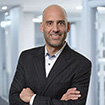One of the more significant advantages of atmospheric plasma treatment is the scalability of the technology. Complex geometries can be addressed by a variety of different jet options and size is of no concern as there is no limit to the number of jets a single system can control.
Plasmatreat’s RD1004 rotational plasma jet allows for manipulation of the plasma into broader, more thermally sensitive streams. This not only allows one jet to treat the width of many, but provides a more gentle treatment option that can be used on films, thin-walled containers, and other thermally sensitive products. These jets can be arranged in any orientation to address different geometries that may be present on a product.
When intense cleaning or speed of treatment is of greater concern, the original straight plasma jet (PFW10) can provide the power necessary to get the job done. These jets fire to a specific point and can be used to set up a curtain of plasma treatment as easily as they can be mounted on a robot to perform a more directed treatment path such as the gasket line on an electronic housing.
Combining the 2 approaches is what allowed Plasmatreat to become the world leader in EPDM Extrusion Treatment. A rotational jet can be used to treat broader areas while a straight jet focuses on treating a deep channel on the same profile. This modularity has always been a great strength or ours and can help you too!
Recommend








Write a comment